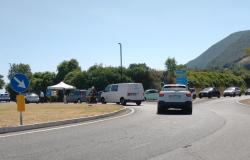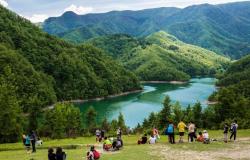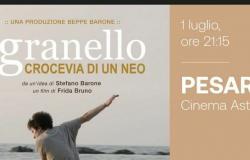Luigi «Gino» Carrara died on Thursday evening, June 27, at Piario hospital, where he had been hospitalized for a few days. On June 21st he turned 88. Originally from Nembro, he has always been deeply attached to his country of origin. But L’Eco di Bergamo, where he worked for over 40 years, has always been his calling. After decades alongside Monsignor Andrea Spada, of whom he was an intelligent and faithful interpreter, he took the reins of management from him, which he led from 1989 to 1995. The funeral will be held on Saturday 29 June, at 11am, in the parish church of Nembro.
Gino Carrara, successor of Monsignor Andrea Spada as director of «The Echo of Bergamo», belongs to that historical nucleus that planned and implemented the modernization of the newspaper, making it the leading provincial paper at the national level: color photos among the first in Italy, new technologies in typography under the iron direction of Paolo Tarchini, increased pagination with entries into the hitherto unexplored territories of the economy and the new flows of customs of civil life. The 70s and 80s, the golden age of the daily newspaper after the difficulties suffered during the season of the first center-left that had allowed the fierce competitor «Giornale di Bergamo» to gain copies where it was already traditionally strong, that is, in the urban belt.
A first class team that Carrara was part of: Giancarlo Zilio, the brothers Renato and Amanzio Possenti, Pino Capellini, Sandro Vavassori, just to mention the most illustrious names. The golden years of «L’Eco», those in which the provincial newspaper left the perimeter of the provincial minority, breaking down its borders and claiming its own role, to present itself – as will be said later – as a glocal newspaper. Capable of interpreting the territory and communicating with the outside, of placing himself on a trajectory that scrutinized the world with his own eyes. Think about it: Spada never leaned towards the «Corriere della Sera» model, if anything he listened to the linear prose of the «Stampa» news of the time and to the acrobatic synthesis between Indro Montanelli’s «Giornale» and the «Repubblica» by Eugenio Scalfari. Yet, like the great opinion newspapers, deliverymen and drivers of «L’Eco» were in official uniform and the reporters had their own company car.
Here, Gino – as everyone called him – has always done without this aesthetic of the persuasive and refined force of a newspaper. Every day on his bike, a humble servant of a cause of which he felt an integral part, not invading other people’s roles: serving the newspaper, with the devotion of a militant, without personal gain. This is where his originality lies, his otherness with respect to the journalistic community, and ultimately his being: the absolute identification with the wishes, and with the whims if you like, of the newspaper. A unique, unrepeatable case: often moving, sometimes incomprehensible even to his friends. Back then, the editorial staff was at the entrance to the newspaper and the leaden typewriters beat out the hard and aggressive sound of the rhythms of a lived chronicle: it had to be seen with the eyes, you had to trudge along the sidewalk. There was no mediation of social media, seeing from a cell phone. Carrara is a child of that time, in which journalism from a pirate and Gascon incursion becomes professional.
The future director arrives from Nembro where he cut his teeth as a correspondent after «Sarpi» and then lands in that small perimeter of those solid counters, emerging from a combative history, which told the story of the becoming of Bergamo. Like everyone else, he tiptoes onto the threshold of journalism on the fringes of the hierarchy and then rises: more by co-optation than by desire. Colleagues and friends, like Marco Nozza who would later become the first national signature of the «Giorno». The man, with those glasses with darkened lenses, maintains a unique trait of himself, not perfectly recognizable to the outside eye, sowing something intriguing in his interlocutors. He doesn’t like the spotlight, he’s an anti-protagonist by temperament, he’s fine with that. He suffers from having to tell his story: he lives in the most absolute discretion. The writer has always thought of his suffering loneliness, protected by his unavailability to competition and by his complicity with a naturally non-conflictual existence.
Work constitutes his existential dimension, to which he dedicates all the energy he has. If Montanelli said that being a journalist is always better than working, Carrara proved the opposite: damn, what a worker. As a journalist he is the jack of all trades, carrying out any task: from News to Entertainment, from Culture to Home Affairs and to the Editorial Secretariat. A man-machine, as the old journalism manuals would have it, attentive to minute news, sentimental and close-by news, to then flow into the general synthesis, a solitary intelligence incompatible with notoriety. That tribe of journalists unknown to most, who build the newspaper, but who do not receive glory: for them, more than others, lunch is not free. They are the forgotten and the unmentioned, those who are not seen, but know that the successes of others are the outcome of their work, as industrious as it is obscure. The “cuisine” of the newspaper, which means having culture and mastery of the profession, in order to then be able to set up pages, editorial projects, intellectual flare-ups. You need competence and familiarity with the fundamentals, an equation that was in the Carrara coordinates. The then director didn’t show them, but we were aware of it.
The direction of «L’Eco» fell upon him after the Spada era: he could only be happy about it. However, he feels the responsibility. A millstone, because in the wake of a Great, the yardstick for those who came after was inevitably that. Carrara governs a complicated transition phase in terms of internal balances, while he has to manage, for a newspaper like «L’Eco», the end of the DC, of the First Republic and the initial phase of Mani pulite and the Second Republic: not exactly a walk in the park. The man moves with balance, he knows how far he can go and where he must retreat, but in this he is also helped by the fact that, not having particular political acquaintances, he has his own autonomous margin of maneuver.
A physical problem forces him to edit the newspaper from home for a few months. For years, anticipating smart working in his own way, he arrived at the editorial office with a couple of pages already prepared at home. Carrara (unmarried, lived with his mother) did not know the usual existential rhythms, other than those dictated by the rhythms of the newspaper. Holidays and rest were usually imposed on him. An authentic and unattainable workaholic. And to think that, for good reasons, for his health and his safety, Bishop Amadei forced him to abandon his bike to come to Nembro, inviting him to use the company car to which he evidently had full right. Nothing to do: docile, but adamant about his things. We like to remember him like this: a friend and an unconventional journalist, who put the success of «L’Eco» before his personal best.





